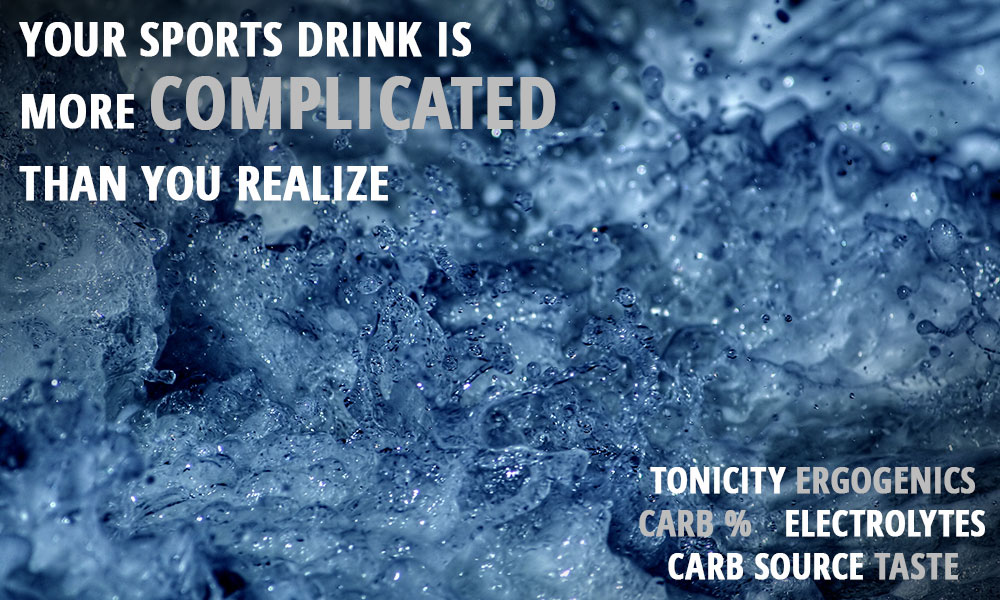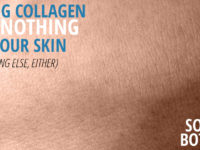I started a different version of this post, but it started getting way too complicated because there’s actually a lot of thought that goes into an effective sports drink. It sounds weird, I know, because they basically amount to little more than slightly salty sugar water—but there are hidden “rules” that must be adhered to or the drink will fail on its most basic premises. And to make things even more complicated, commercial manufacturers need to worry about marketability, which means adding unnecessary but vogue ingredients that must be accounted for in the final formulation.
So I’m starting over, and instead of going complicated, I’m going to go as simple as possible—even if takes a few articles to cover everything I originally wanted to throw in here. For now, we’ll start with the basic “concept” of a sports drink and then review some common ingredients commercial manufacturers use.
Sports Drink Concepts
Even though sports drinks are basically slightly salty sugar water, you can’t just throw random amounts of salt and sugar into it. There is a necessary precision, beginning first with respecting the tonicity of the beverage.
Tonicity & Osmolality
Our blood has an osmolality of about 280 to 300 milliosmoles per liter, which is basically a measure of how many molecules are dissolved in it. For a sports drink to effectively hydrate, it needs to have the same osmolality or a lesser one. If a drink’s osmolality is greater than our blood’s, then it will cause liquid to be pulled from the blood and into the intestine to equalize the two concentrations and (at least briefly) worsen hydration. For a supplement whose primary job is to hydrate, this is a no-no. Therefore, all sports drink ingredients need to be carefully considered; throwing in random stuff will cause undue increases in tonicity/osmolality.
Carbohydrates are almost the only contributor to osmolality you need to worry about, followed by sodium. These two ingredients are present in the most numerous amounts, so they pay the highest price. Most other ingredients contribute only minorly, but can and do add up if not carefully considered; therefore, restraint is necessary across the board. This will make more sense when you see some figures for different ingredients below.
Carbohydrate Content
Aside from tonicity, carbohydrate content can also affect a sports drink’s ability to hydrate. Drinks with a 6-8% carbohydrate concentration (roughly 60 to 80 grams of carbohydrate per liter of beverage) are actually absorbed faster than pure water. When carbohydrates increase past around 8%, hydration can slow because the energy density of the drink will trigger slower stomach emptying, delaying absorption from the small intestine. Thus, most sports drinks aim to be between 6-8% carbohydrate and few go above 8%.
Sports drinks must also consider the simplicity of the carbohydrate source. The simplest two sources, pure glucose and pure fructose, are the fastest absorbed but also exert the greatest effect on tonicity; it’s impossible to achieve a 6-8% solution with pure glucose and fructose alone. Most manufacturers use disaccharides or polysaccharides instead, like sucrose (glucose bonded to fructose), maltose (glucose bonded to glucose), or maltodextrin (a chain of three to twenty glucoses). These have a far lesser effect on tonicity but are still very quickly absorbed.
Finally, the ratio of glucose to fructose is important. We can absorb only limited amounts of carbohydrates every hour—60 grams of glucose and 30 grams of fructose. Only glucose can power muscular activity, but fructose can still impact exercise by replenishing liver glycogen to keep blood glucose stable, thereby reserving more glucose for the muscles. Most drinks aim for a 2:1 ratio of glucose to fructose, as in 40 grams of glucose and 20 grams of fructose, but for climbers the fructose is probably unnecessary except for particularly long or intense sessions/days, and 60 grams of glucose will be plenty for most situations. Don’t exceed 30 grams of fructose per hour, as it can cause GI distress as the unabsorbed fructose is fermented by our gut bacteria.
Electrolytes
There are five electrolytes commonly added to sports drinks, though only two are truly necessary for 99.9% of athletes (including climbers): sodium and chloride. The other three are potassium, calcium, and magnesium. While we do sweat these electrolytes out as well, they are in such small quantities that only ultraendurance athletes—who sweat heavily for hours in a row and do not have the time to eat normal food–would ever need to supplement them.
| Electrolyte Loss Per Liter of Sweat | |
| Sodium | 460-1,840 mg |
| Chloride | 700-2,120 mg |
| Potassium | 156-312 mg |
| Calcium | 0-40 mg |
| Magnesium | < 5 mg |
Sodium and chloride, on the other hand, can overwhelm normal daily intake even when exercise isn’t terribly long provided sweat rate is normal to high (the average athlete in normal conditions produces around a liter of sweat per hour; in hot or humid conditions, sweat rate can increase to 2.5 liters per hour). On a single day basis, this is no big deal—we have a store of sodium on the surface of our bones that can sustain blood sodium—but if you exercise frequently for long periods of time or in sweaty conditions then you run the risk of hyponatremia (low blood sodium). This can easily be prevented by adding salt to your drink, or choosing a high-sodium beverage.
Ideally your beverage should contain 575 milligrams to 1,725 milligrams of sodium (¼-¾ tsp) per liter, an amount that will help you maintain blood sodium over the long run without significantly affecting taste or adding undo amounts of sodium to the diet. Maintaining blood sodium will keep blood volume high, thereby increasing oxygen delivery to muscles, improving metabolic byproduct removal (ammonia, lactate, etc.), and increasing sweat rate (i.e., improved cooling). Government recommended upper intakes (2,300 mg/day in the US) are not meant to apply to athletes and it’s not recommended you attempt to adhere to them. If you eat healthfully and salt your sports drinks, you’ll be good to go sodium-wise.
Sports Drinks Ingredients
I’ve grouped common sports drink ingredients together by function (carbohydrate, electrolyte, and other). For each of these groups, I’ve included relevant information such as the number of millimoles per unit (important for determing tonicity) and also the overall rating for the “utility” of the ingredient, running from an “A” (all drinks should have this) to an “F” (why would they put this in a sports drink).
A quick note on utility ratings: These are meant to apply to the utility for climbers specifically, and not meant to indicate it’s an ingredient you should avoid when looking for a sports drink. Many of the “F” ingredients will be found in most or all commercial sports drinks because they are a) marketing their product to a broad audience and b) attempting to satisfy the requirements of the 0.01% of athletes who might need some magnesium or calcium in their drinks. If you’re buying a commercial drink, a better resource to use is my handy sports drink review guide.
Carbohydrates
| Utility | Rec. Amount per Liter | Milliosmoles per 10 grams | |
| Glucose | A | < 60 g* | 55.5 |
| Fructose | D | < 30 g** | 55.5 |
| Sucrose | B | < 60 g** | 29.2 |
| Maltose | A | < 60 g* | 29.2 |
| Maltodextrin | A | < 60 g* | 11.44*** |
*All sources of glucose should total no more than 60 grams per liter as glucose absorption caps at 60 grams per hour.
**All sources of fructose should provide no more than 30 grams of fructose per liter as fructose absorption caps at 30 grams per hour and excess can cause GI distress.
***Maltodextrin can vary from a chain as short as 3 glucose molecules long to one that is 20 molecules long, so the number of milliosmoles per 10 grams can vary dramatically (from 3.06 to 19.82). I averaged them out since it’s impossible to know exactly how long each chain is in a product.
I gave fructose a “D” rating because sucrose is a better choice 99% of the time. Sucrose is 50% glucose, 50% fructose so 60 grams will provide the recommended maximum of 30 grams fructose. Fructose may only be a better choice if you happen to like really, really sweet sports drinks because fructose has a greater sweetness per gram than any other carbohydrate.
Sucrose gets a “B” because it’s only useful for climbers when total carbohydrate intake from sports drinks will exceed 60 grams per hour. If you’re planning on climbing for 3+ hours, or will be out climbing off and on for an entire day, then the fructose from the sucrose will help keep blood sugar more stable by selectively replenishing liver glycogen (fructose cannot be metabolised by the muscles, only the liver, and the liver is better [faster] at making glycogen from fructose than glucose).
All other carbohydrates get “A”s because they are sources of pure glucose. Glucose is the sweetest, followed by maltose, and maltodextrin has virtually no taste at all (which is good or bad depending on whether you like sweet or neutral sports drinks). Maltodextrin has the least effect on osmolality, and is the best choice to keep tonicity low.
Electrolytes
| Utility | Rec. Amount per Liter | Millimoles per 100 milligrams* | |
| Calcium | F | < 40 mg | |
| …Citrate | 4.16 | ||
| …Gluconate | 7.49 | ||
| …Malate | 8.23 | ||
| Magnesium | F | < 5 mg | |
| …Carbonate | 8.23 | ||
| …Lactate | 12.34 | ||
| …Malate | 8.23 | ||
| Potassium | D | < 300 mg | |
| …Chloride | 5.12 | ||
| …Citrate | 3.41 | ||
| [Mono]…Phosphate | 5.12 | ||
| [Di]…Phosphate | 3.84 | ||
| Sodium | A | 500 – 2,000 mg | |
| …Chloride | 8.70 | ||
| [Tri]…Citrate | D | 5.80 |
*Minerals are chelated to organic molecules that determine in large part the total effect on tonicity; thus, each common mineral chelate is listed separately to distinguish those differing effects. The number of millimoles (mM) is determined per 100 mg of the mineral itself (i.e., the math determining what percentage of each total compound the mineral makes up has already been done, just consider the mineral amount listed on the “Nutrition Facts” part of the label).
Calcium and magnesium receive “F” grades because they contribute virtually nothing to a climber. In three hard hours of climbing straight, less than 120 mg of calcium and 15 mg of magnesium will be lost, both easily replenished by food.
Potassium receives a “D” because it is nearly as useless as calcium and magnesium, but significant amounts can potentially be lost during exercise. The impact of this loss on the exercise itself is likely to be minimal, but if the rest of your diet is chronically potassium-inadequate and you exercise frequently and for long periods of time then eventually you may experience performance consequences. Still, you’re better off improving dietary potassium intake (potatoes, sweet potatoes, kiwis, bananas, oranges, and beans are all good sources).
Sodium gets an “A” because it’s an essential part of every sports drink. Sodium citrate gets a “D”, though, because if you use sodium citrate you must find a different source for chloride, an electrolyte also lost in significant amounts. Sports drink manufacturers will usually have done the math, but when formulating your own drink it’s recommended to just stick with sodium chloride (table salt).
Other Common Ingredients
| Utility | Rec. Amount | Millimoles per gram | |
| Vitamin B3 | F | 0 | —–* |
| Vitamin B6 | F | 0 | —–* |
| Vitamin B12 | F | 0 | —–* |
| Vitamin C (Ascorbic Acid) | F | 0 | 5.68 |
| Vitamin E | F | 0 | —–* |
| Citrulline Malate | C | < 6 g | 3.23 |
| BCAAs | F | 0 | 7.85 |
| Glutamine | F | 0 | 6.84 |
| Whey Protein | C | < 20 g | 0.047 |
*With the exception of vitamin C, no vitamin will be added to sports drinks in amounts great enough to influence tonicity. Most vitamins are required in low milligram (or even microgram) amounts, with vitamin C being a notable exception (RDAs are 90 mg for men and 75 mg for women).
There aren’t many ingredients worth adding to a sports drink not already covered. Still, there are a few that commonly make their way into commercial drinks; for the most part, they are little more than marketing gimmicks reflecting what athletes think they need rather than what actually helps.
All B vitamins receive an “F” because they have zero effect on athletic performance either in the moment or in general (aside through exceptionally rare deficiencies). B vitamins only get added because they are popularly known as the vitamins responsible for energy metabolism; true though this may be, they work in the background and there is no probable mechanism through which they could influence performance.
Ascorbic acid, or “Vitamin C”, gets an “F” because it has repeatedly been shown to have virtually no effect on exercise aside from ever-so-slightly reducing the risk of upper respiratory tract infections in endurance athletes; it’s often added as an antioxidant in order to hypothetically decrease muscle damage and improve recovery. In reality, recent research suggests supplemental vitamin C may actually hinder training-adaptation and therefore impair performance longterm, making this a particularly ill-advised addition to a sports drink.
Vitamin E gets an “F” because it contributes nothing to a sports drink. It’s an antioxidant like vitamin C, added to drinks for similar reasons, and causes the same decrease in training adapatation. Not recommended.
Citrulline malate gets a “C” because it is questionably effective at increasing and maintaining higher than normal levels of nitric oxide, with potential performance boosts. Much more can be read about citrulline malate here. Citrulline malate also imparts a pleasant sour taste to a sports drink, which is desirable for some people.
BCAAs get an “F” because they are probably ineffective for climbers, and certainly less effective than complete sources of protein. BCAAs are added because they may attenuate fatigue slightly in endurance athletes, but only after two hours. If you have the chance to consume whole protein sources (and you do, because you’re a climber with the opportunity to eat regular food occasionally), they will be more effective at reducing fatigue.
Glutamine gets an “F” because, like BCAAs, it is apparently only effective in endurance events past the 2-hour mark, and because (like BCAAs again) whole protein sources are probably more effective anyway.
Whey protein gets a “C” because it may potentially be worthwhile to add in certain scenarios, but is still generally not necessary. If you will be exercising for three hours or longer, and will not have the chance to consume protein from another source during that time, then adding a rapidly digested and absorbed protein like whey can attenuate fatigue and help prevent undo muscle damage. In other words, if you cannot realistically consume protein from another source every three hours while exercising, then adding it to your sports drink (or finding one with it added already) may help you last longer and stronger.
Final Thoughts
This post sets the groundwork for a number of posts to come. It’s not important to memorize any of the figures, they’re there to help you understand how I come to my conclusions in future articles.
The most important thing you can take away from this article is that the osmolality of a sports drink should never exceed 300 mOs/L. Most of it will come from carbohydrates, then sodium and chloride. Be aware of these ingredients and you’ll probably be fine.















Any thoughts on the utility of BCAAs for preventing muscle loss during weight loss?
In general, I think a complete protein is still a better option—even for weight loss, even for specific diets like intermittent fasts where all food is usually discouraged (I advise people to ignore that rule and just have protein shakes, if that is the path they want to take)—because we know for certain it will have the desired effect (a reduction in lean muscle loss). BCAAs may be effective as well, but the evidence isn’t 100% clear, and there’s really no advantage to them since the whole protein will add only a minuscule number of burnable calories to one’s daily total.